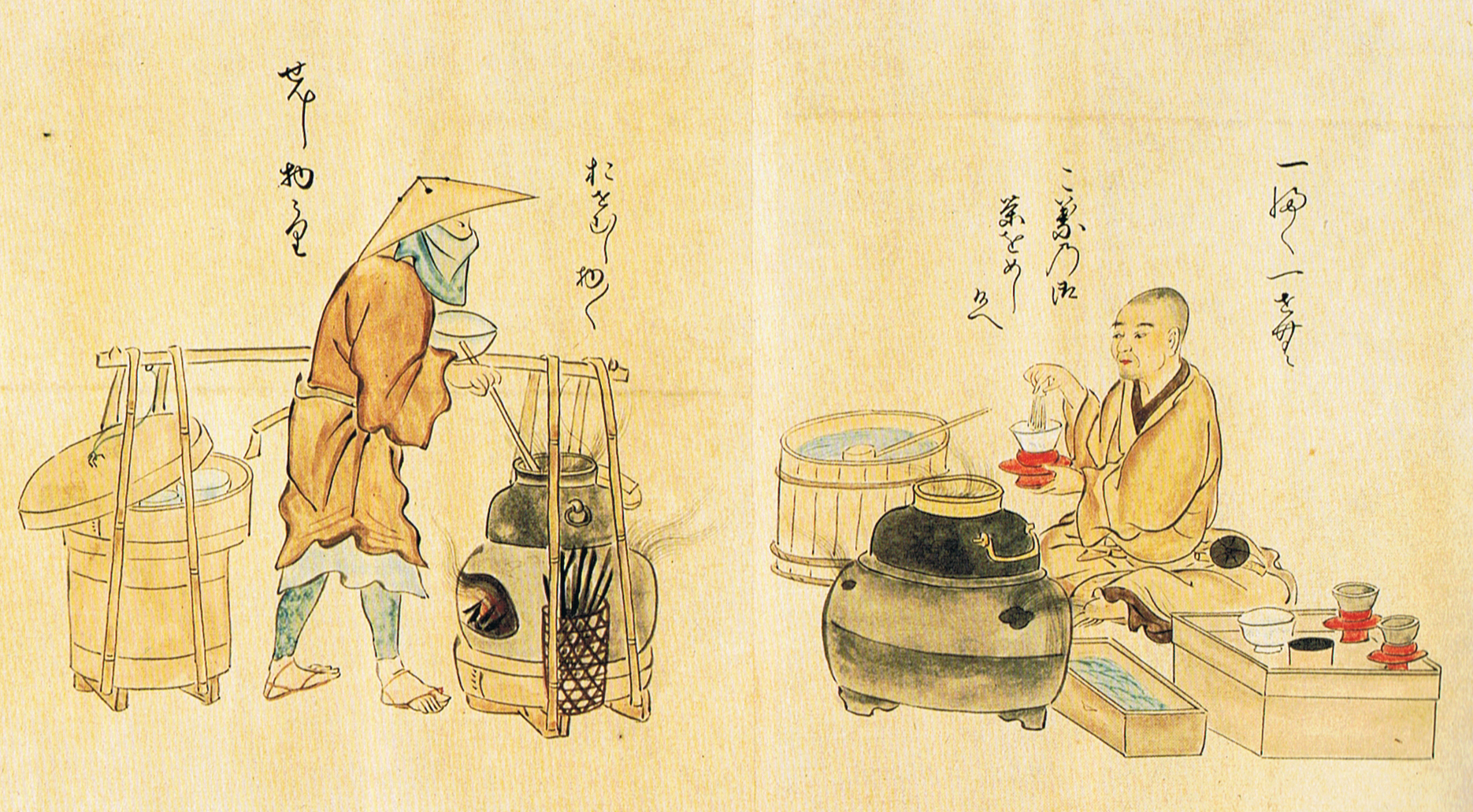![]() Publicado en Japan - Entretenimiento y Ocio - 16 May 2016 00:13 - 3
Publicado en Japan - Entretenimiento y Ocio - 16 May 2016 00:13 - 3

"Tea is nought but this;
First you heat the water,
Then you make the tea.
Then you drink it properly.
That is all you need to know."
TEA
Also known as the Way of the Tea, the Japanese tea ceremony is the traditional method of preparing and drinking matcha, or powdered green tea. The ceremony is called sado (茶道) or chanoyu (茶の湯) in Japanese culture. The manner in which the event is performed is called otemae. The tea ceremony is highly influenced by the principles of Zen Buddhism.
Tea gatherings are clified as chaji (茶事) or chakai (茶会). A chakai is a simple hospitality event that includes thin tea, confections, and a light meal. A chaji is a formal gathering that includes a full course kaiseki meal followed by confections, thick tea, and then thin tea. A chaji ceremonial gathering lasts for at least four hours.

ORIGINS
The earliest tea ceremony came to Japan in the 6th century as a significant part of Buddhist meditation. The first documented tea in Japan dates back to a Buddhist monk, Eichu, as he arrived from China in the 9th century. Eichu was believed to have served green tea personally tea to Emperor Saga in 819 while on an excursion in Karasaki.
At the end of the 12th century, another Buddhist monk named Eisai introduced tencha (tea preparation) to Japan. He brought with him seeds that yielded high quality tea leaves. During the Kamakura Shogunate, tea became a status symbol of the warrior cl. During this time, tea tasting parties came into wide practice in Japan, regardless of society level. Many tea ceremony schools have evolved throughout the history of chado and are still active today.

VENUE
Any room or space where the needed implements for tea preparation can be set and where the host can make tea in front of their seated guests may be used. An outdoor, picnic-style gathering is known as nodate (野点).
A chasu is a room specially built for tea ceremonies. It has a waiting area, tatami floors, a low ceiling, shoji (screens), an alcove for scrolls, a hearth built into the floor, and several entrances for guests and host.

A few things all tearooms have in common is that the floor is covered with Tatami mats. Usually there is an alcove or Tokonoma in the room, but its size may vary. There are different sizes of rooms which have names according to the number of Tatami mats in the room or the layout of the Tatami mats. For example, a four-and-a-half Tatami mat room is called a Koma (small room). There is no fixed layout, as to where the door has to be in relation to the host’s mat but the guests should be seated next to or near the Tokonoma so the host’s mat cannot be in the same corner.

1 - Sadouguchi (Host's entrance)
The Sadouguchi is a full-sized door the host uses to enter and exit the tea room carrying utensils. Commonly, a Taikobusuma sliding door is used. The Taikobusuma is comprised of a lattice frame with white paper affixed to both sides. There is no knob or handle, and the door is simply pushed open by hand.
2 - Tokobashira (Supporting pilar)
Much care is put into crafting the Tokobashira supporting pilar, for it is almost like the face of the Tokonoma. High grade wood or that which conveys an air of sober refinement (Wabi) is used. Red pine is sometimes used as Tokobashira and the bark could be left on. The pilar located on the opposite side from the Tokobashira is called an Aitebashira or partner pilar.
3 - Otoshigake (Tokonoma Lintel)
The Otoshigake is the lintel that supports the partial short wall in front of the Tokonoma alcove. It is commonly made of red ceddar, red pine, or Paulownia wood. A nail is hammered on the from surface of the center of the wood, and sometimes the back, and a small boat-shaped hanging vase of flowers can be hung from it.
4 - Kakejiku (Hanging scroll)
In these scrolls, calligraphy or painting are usually mounted. Calligraphy includes such as Waka poetry, letters and Zen phrases written by monks, while paintings are about landscape scenery, flowers, birds and so on. Vintage brocades used for the frame shouldn't be missed. Guests can see the point of the day's tea ceremony. On this hanging scroll is a prase describing the summer season.
5 - Tokogamachi (Tokonoma bottom beam)
6 - Temaeza (Tea master's tea mat)

ELEMENTS
Chadogu (茶道具) refers, collectively, to tea equipment. A wide variety of chadogu designs fits every season and event. Tools used in the ceremony are usually handled with much care. They are cleaned very well before and after use. The Japanese culture values the ritual so much that some chadogu are handled only with gloved hands.
Chakin (茶巾). A small rectangular hemp cloth or linen to wipe the tea bowls.
Natsume (棗). A small lidded tea caddy that holds the tea for brewing.
Chawan (茶碗). A tea bowl. Chawans come in a wide range of styles and sizes. Shallow tea bowls are used in summer so that the tea cools easily, while deep bowls are lar in the winter.
Chasen (茶筅). Tea whisk to mix the hot water and powdered tea, usually made from a single piece of bamboo.
Chashaku (茶杓). A tea scoop, of bamboo, wood, or ivory, to transfer tea into the tea caddy.


THE CEREMONY
The Japanese tea ceremony varies from one school of thought to another, as well as with the time of day, season, venue, and other important factors. Guests usually arrive earlier than the appointed time and enter the waiting room, where they store coats and put on tabi (足袋) or traditional Japanese socks.
The guests then proceed to a stone basin where they wash their hands and rinse their mouths with water, continuing to the tea house. They then sit on the tatami in order of status. When everyone is seated, the host is alerted through a sound created by the closing of the door.

The chaji starts with the laying of a charcoal fire to heat the water. Guests are then served each course of food, followed by a sweet edible paper called kaishi. After the meal, guests take a break in the waiting area. When they are summoned back, they perform the cleansing ritual again and sit in their original positions.
The host performs the ritual of cleansing the utensils in front of the guests. The host exchanges bows with each guest receiving tea. The guest rotates the bowl (to avoid drinking from the front), takes a sip, and compliments the host. After a few sips, the guest then wipes clean the bowl’s rim and pes it to the next guest.
After everyone has taken their sip from the bowl, the host adds more charcoal to the fire and brings more confections and a smoking set to the tea room. The host prepares an individual bowl for each guest. After all the guests finish their tea, the host cleans the chadogu and at the same time allows guests to take a look at them. Items are treated with extreme care, as they may be priceless, irreplaceable antiques.
IN ANIMATION
Hyouge Mono - The story is set during Japan's Sengoku Jidai (Era of the Warring States) and centers on Furuta Sasuke, a val of the great warlord Oda Nobunaga and a man obsessed with tea ceremony and material desires in his pursuit of a fortuitous life. Having learned from Oda and the legendary tea master Senne Soueki, Furuta walks the way of the Hyouge Mono.



Endosar
eCarterno0bsailbotComentarios (3)





